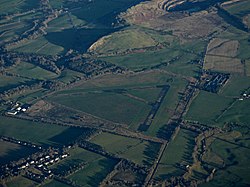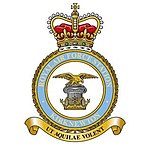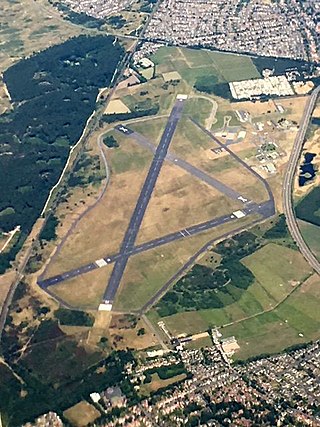
Royal Air Force Woodvale or more simply RAF Woodvale is a Royal Air Force Station located 4 mi (6.4 km) next to the towns of Formby and Ainsdale in an area called Woodvale which is located to the south of Southport, Merseyside. Woodvale was constructed as an all-weather night fighter airfield for the defence of Liverpool. However, it did not open until 7 December 1941 which was just after the Liverpool Blitz which peaked in May of that year.

Royal Air Force Halton, or more simply RAF Halton, is one of the largest Royal Air Force stations in the United Kingdom. It is located near the village of Halton near Wendover, Buckinghamshire. The site has been in use since the First World War but is due to close by December 2027.

Royal Air Force Kinloss, or more simply RAF Kinloss, is a former Royal Air Force station located near the village of Kinloss, on the Moray Firth in the north east of Scotland, UK.

Royal Air Force Cranwell or more simply RAF Cranwell is a Royal Air Force station in Lincolnshire, England, close to the village of Cranwell, near Sleaford. Among other functions, it is home to the Royal Air Force College (RAFC), which trains the RAF's new officers and aircrew. The motto, Altium Altrix, meaning "Nurture the highest" appears above the main doors of the Officers Mess. Since January 2023, RAF Cranwell has been commanded by Group Captain Tina Jessup.

Royal Air Force Barkston Heath or RAF Barkston Heath is a Royal Air Force Relief Landing Ground under the command of RAF Cranwell near Grantham, Lincolnshire, England.
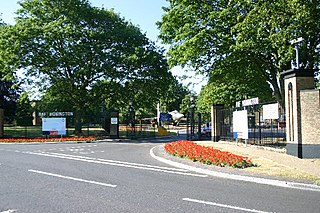
Royal Air Force Honington or more simply RAF Honington is a Royal Air Force station located 6 mi (9.7 km) south of Thetford near Ixworth in Suffolk, England. It was used as a bomber station during the Second World War and through the Cold War, hosting Handley Page Victors and Hawker Siddeley (Blackburn) Buccaneers. RAF Honington has been the RAF Regiment depot since 1994.

Royal Marines Barracks Chivenor is a British military base used primarily by 3 Commando Brigade. It is situated on the northern shore of the River Taw estuary, adjacent to the South West Coast Path, on the north coast of Devon, England. The nearest towns are Barnstaple and Braunton.

Royal Air Force Linton-on-Ouse or more simply RAF Linton-on-Ouse is a former Royal Air Force station at Linton-on-Ouse in North Yorkshire, England, 10 miles (16 km) north-west of York. It had satellite stations at RAF Topcliffe and Dishforth Airfield.

Royal Air Force Syerston, commonly known simply as RAF Syerston, is a Royal Air Force station in the parish of Flintham, near Newark, Nottinghamshire, England. Opened in 1940, it was used by the Royal Air Force (RAF) as a bomber base during the Second World War, operating Vickers Wellingtons, Avro Manchesters, and the Avro Lancaster heavy bombers. Post-war, it became home to Jet Provosts of the 2 Flying Training School. It is now home to the Royal Air Force Central Gliding School.

Royal Air Force Topcliffe or RAF Topcliffe is a Royal Air Force station in North Yorkshire, England.

Royal Air Force Tern Hill, or more simply RAF Tern Hill, was a Royal Air Force station at Ternhill in Shropshire, England, near the towns of Newport and Market Drayton.

A Volunteer Gliding Squadron (VGS) is an aircraft squadron of the Royal Air Force (RAF) which provides flying training in glider aircraft for Royal Air Force Air Cadets. All current operational Volunteer Gliding Squadrons operate a sole type of aircraft, the Grob G103A Twin II Acro, a conventional winch-launched tandem-seat sailplane known by its British military designation, Viking T1.

Royal Air Force Hullavington, or more simply RAF Hullavington, was a Royal Air Force station located at Hullavington, near Chippenham, Wiltshire, England. The station opened in June 1937 and was primarily used for training. It closed on 31 March 1992 when it was transferred to the British Army and renamed Buckley Barracks. The airfield part of the site, known as Hullavington Airfield, continued to be used for RAF gliding operations until 2016 when it was sold to technology company Dyson.
Royal Air Force Kirton in Lindsey or more simply RAF Kirton in Lindsey is a former Royal Air Force station located 15 miles (24 km) north of Lincoln, Lincolnshire, England.

Royal Air Force Upavon, or more simply RAF Upavon, is a former Royal Air Force station in Wiltshire, England. It was a grass airfield, military flight training school, and administrative headquarters of the Royal Air Force. The station opened in 1912 and closed in 1993, when it was transferred to the British Army and became known as Trenchard Lines.

Royal Air Force Cosford or RAF Cosford is a Royal Air Force station in Cosford, Shropshire, England just to the northwest of Wolverhampton and next to Albrighton.
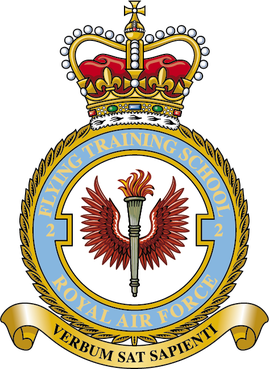
No.2 Flying Training School is a Flying Training School (FTS) of the Royal Air Force (RAF). It is part of No. 22 (Training) Group that delivers glider flying training to the Royal Air Force Air Cadets. Its headquarters is located at RAF Syerston in Nottinghamshire and gliding takes places from several sites throughout the UK using the Grob Viking T1. The RAF Central Gliding School is also under its command.
This is the structure of the Royal Air Force, as of October 2020.
